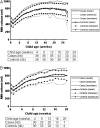Cumulative exposure to cell-free HIV in breast milk, rather than feeding pattern per se, identifies postnatally infected infants
- PMID: 21367736
- PMCID: PMC3049337
- DOI: 10.1093/cid/ciq203
Cumulative exposure to cell-free HIV in breast milk, rather than feeding pattern per se, identifies postnatally infected infants
Abstract
Background: We quantified the relationship between human immunodeficiency virus (HIV) RNA shedding in breast milk, cumulative RNA exposure, and postnatal transmission, relating timing of infection in the infant to estimated total volume of milk exposure.
Methods: Nested case-control study of 36 infants of HIV-infected mothers. Case patients were infants who acquired HIV infection through breastfeeding from age 6 through 28 weeks, and control subjects were uninfected infants matched on age at obtainment of a breast milk sample. Mothers and infants received peripartum single-dose nevirapine prophylaxis. Feeding data were collected daily; breast milk samples were collected and infant anthropometry was performed at 6 weeks and monthly thereafter. Volume of milk ingested was estimated using infant weight and feeding pattern.
Results: Before HIV acquisition in case patients, feeding pattern (exclusive breastfeeding; median duration, 65 vs 70 days; P = .6) and daily milk intake (mean volume, 638 vs 637 mL; P = .97) did not differ significantly between case patients and control subjects. Case mothers were more likely to shed virus (64% vs 9% always, 22% vs 20.5% intermittently, 14% vs 70.5% never shed; overall, P < .001). Case patients ingested ~15 times more HIV-1 RNA particles than did control subjects (196.5 vs 13 × 10⁶ copies; P < .001). Allowing for maternal antenatal CD4 cell count and plasma HIV-1 load, child sex and duration of mixed breastfeeding, the association between HIV RNA exposure and infection remained statistically significant (P < .001).
Conclusions: Postnatal acquisition of HIV-1 is more strongly associated with cumulative exposure to cell-free particles in breast milk than with feeding mode. Reducing breast milk viral load through antiretroviral therapy to mother or child can further decrease postnatal transmission in exclusively breastfed infants.
Figures
Comment in
-
New information on the relationship between exclusive breastfeeding and lower mother-to-child HIV transmission.Clin Infect Dis. 2011 Jul 15;53(2):208-9; author reply 209. doi: 10.1093/cid/cir310. Clin Infect Dis. 2011. PMID: 21690632 Free PMC article. No abstract available.
References
-
- UNAIDS/UNICEF/WHO. Rapid advice: revised principles and recommendations on infant feeding in the context of HIV. Geneva, Switzerland: WHO/UNAIDS; 2009.
-
- Coovadia HM, Rollins NC, Bland RM, et al. Mother-to-child transmission of HIV-1 infection during exclusive breastfeeding in the first 6 months of life: an intervention cohort study. Lancet. 2007;369:1107–6. - PubMed
-
- The Breastfeeding and HIV International Transmission Study Group. Late postnatal transmission of HIV-1 in breast-fed children: an individual patient data meta-analysis. J Infect Dis. 2004;189:2154–66. - PubMed
-
- Iliff PJ, Piwoz EG, Tavengwa NV, et al. Early exclusive breastfeeding reduces the risk of postnatal HIV-1 transmission and increases HIV-free survival. AIDS. 2005;19:699–708. - PubMed
Publication types
MeSH terms
Substances
Grants and funding
LinkOut - more resources
Full Text Sources
Medical
Research Materials


